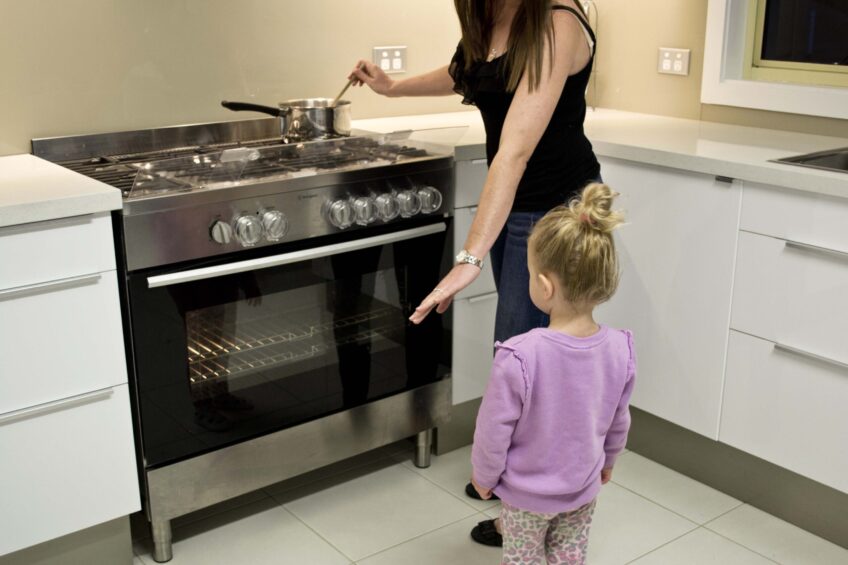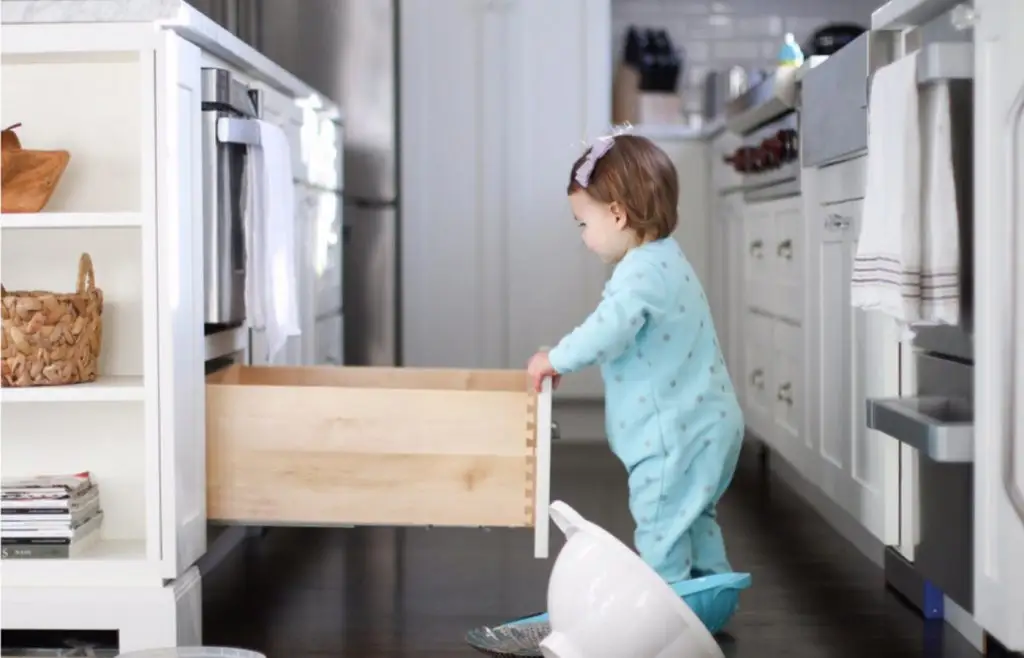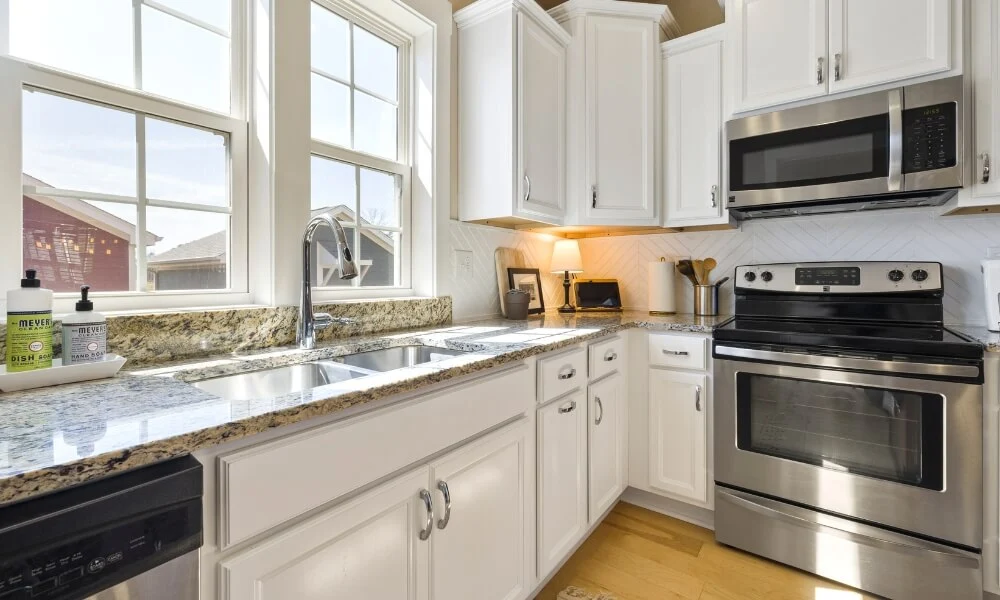For interior designers and contractors, the kitchen is the heart of the home. This is where homeowners prepare delicious meals and make memories. But it’s also a space where accidents can occur if safety measures aren’t taken seriously.
In this blog post, we’ll delve into crucial kitchen safety tips to guarantee that safety is the top priority in every home.
Common Kitchen Hazards

In the following sections, we’ll explore common kitchen hazards—shedding light on simple yet crucial measures to ensure your kitchen projects remain a place of joy and well-being for homeowners.
1. Hot Surfaces and Appliances
The kitchen is busy, filled with surfaces and appliances that can get hot. Accidentally touching stovetops, ovens, or toaster ovens can lead to painful burns. It’s crucial to be careful around these hot appliances. Always use potholders when dealing with hot trays or pans and remember that surfaces can stay hot even after cooking, so stay cautious.
2. Boiling Liquids
Boiling liquids pose a significant risk in the kitchen, especially when cooking on stovetops. Spills and splashes from boiling water or hot liquids can lead to severe scalds. To prevent this hazard, use caution when stirring hot liquids and consider using long-handled utensils to avoid unnecessary proximity to the heat source. Tilt lids away from you to allow steam to escape safely when handling pots or pans containing boiling substances.
3. Sharp Knives and Utensils

Sharp knives are vital tools in the kitchen, but they also present a potential hazard. Improper handling or a momentary lack of attention can lead to cuts and injuries. Always use a cutting board to provide a stable surface, and keep knives sharp to reduce the likelihood of slips. Additionally, adopt a proper cutting technique, keeping fingers away from the knife’s path. Knives need to be stored in a designated block or on a magnetic strip to avoid accidental contact when not in use.
4. Broken Glassware
Glassware, such as dishes, cups, and utensils, is common in the kitchen. Accidents happen, and glassware can break—leading to sharp shards that pose a risk of cuts. Take care when handling glass items, especially when washing or transporting them. Dispose of broken glass carefully and thoroughly clean the area to eliminate residual fragments.
5. Cooking Oil and Grease
The use of oil and grease in cooking presents a significant fire risk. When oil surpasses its smoke point, it can ignite rapidly. To reduce this hazard, use a thermometer to track the temperature of the cooking oil and refrain from leaving it unattended on a heated stove. If a minor oil fire occurs, promptly cover it with a lid to suppress the flames. Steer clear of using water to extinguish a fire, as it can worsen things. Also, to reduce potential risks, ensure a safe distance between the cooking area and flammable items like paper towels and dishcloths.
6. Electrical Appliances
Faulty wiring or damaged cords can lead to electrical fires. Regularly inspect electrical cords for signs of wear or damage and immediately replace any compromised appliances. When not in use, make sure to unplug appliances. Avoid overloading electrical outlets. Practicing good electrical safety habits reduces the risk of kitchen fires caused by faulty appliances.
Essential Kitchen Safety Tips

Ensuring kitchen safety is a fundamental requirement for contractors, builders, and interior designers. Kitchens, commonly regarded as the core of a home, become bustling hubs during construction or renovation. Implementing crucial safety measures is not only about ensuring the safety of the workforce but also plays a role in enhancing the overall efficiency and success of the project.
- Work Areas Security: Prioritize establishing secure work zones within the kitchen. Use barriers, caution tape, or signage to mark areas where work is in progress, helping prevent unauthorized access and potential accidents.
- Personal Protective Equipment (PPE): Make sure workers wear the proper PPE, including safety glasses, gloves, and steel-toed boots. Personal protection is the first defense in the kitchen environment, with a high risk of sharp objects and falling debris.
- Electrical Safety: Kitchens are often filled with various electrical appliances. Ensure that all workers are trained to handle electrical equipment safely. Utilize ground fault circuit interrupters (GFCIs) to prevent electrical shocks and keep power cords away from water sources to avoid potential electrical hazards. Install access doors to conceal electrical wiring for kitchen appliances. Explore Best Access Doors for a selection of access doors contributing to a secure kitchen environment.
- Proper Tool Usage: Educate workers on correctly using tools and equipment. Keep tools in good working condition and provide regular training on appropriate handling. This includes ensuring that cutting tools are sharp, reducing the risk of accidents caused by too much force.
- Slip and Fall Prevention: Kitchens can be slippery environments, especially during construction or renovation work. Implement measures to prevent slips and falls, such as using non-slip flooring materials, placing warning signs in wet areas, and promptly cleaning up spills.

- Fire Safety: Kitchens pose a higher fire risk due to gas appliances, electrical equipment, and flammable materials. Install fire extinguishers in easily accessible locations and conduct regular fire drills. Workers should be familiar with emergency exits and evacuation procedures.
- Tool Safety: Contractors and builders often work with a variety of tools. Ensure that all tools are in good condition and that workers are trained in their proper usage. Storing tools in designated areas is essential to prevent tripping hazards and injuries.
- Ventilation: Construction and renovation activities can generate dust, fumes, and other airborne particles. Adequate ventilation is important in maintaining air quality. Use exhaust fans to improve air circulation and reduce respiratory hazards.
- Sharp Object Safety: Interior designers may frequently handle sharp objects such as utility knives, scissors, or other cutting tools. Stress the importance of proper handling, storage, and disposal of sharp objects to prevent accidental injuries.
- Ladder Safety: Workers often must reach high places in a kitchen construction or renovation project. Ensure the use of sturdy, well-maintained ladders and provide proper training on ladder safety. Avoid overreaching and ensure the ladder is on stable ground.
- Communication: Effective communication is critical to preventing accidents. Establish communication channels among team members to convey safety protocols and promptly address concerns. Regular safety meetings help emphasize the importance of safety on the job site.
Conclusion
By adhering to safety protocols and incorporating practical solutions, such as access doors for concealing wiring, we empower contractors and interior designers to create aesthetically pleasing kitchens but also ensure the well-being of everyone involved. As the saying goes, “Safety First,” and this mantra holds paramount significance in kitchen design and construction.

